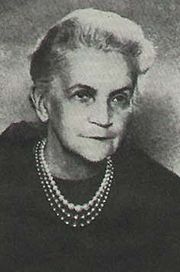In mathematical logic, a Gödel numbering is a function that assigns to each symbol and well-formed formula of some formal language a unique natural number, called its Gödel number. The concept was used by Kurt Gödel for the proof of his incompleteness theorems. (Gödel 1931)
A Gödel numbering can be interpreted as an encoding in which a number is assigned to each symbol of a mathematical notation, after which a sequence of natural numbers can then represent a sequence of symbols. These sequences of natural numbers can again be represented by single natural numbers, facilitating their manipulation in formal theories of arithmetic.
Since the publishing of Gödel's paper in 1931, the term "Gödel numbering" or "Gödel code" has been used to refer to more general assignments of natural numbers to mathematical objects.
A Gödel numbering can be interpreted as an encoding in which a number is assigned to each symbol of a mathematical notation, after which a sequence of natural numbers can then represent a sequence of symbols. These sequences of natural numbers can again be represented by single natural numbers, facilitating their manipulation in formal theories of arithmetic.
Since the publishing of Gödel's paper in 1931, the term "Gödel numbering" or "Gödel code" has been used to refer to more general assignments of natural numbers to mathematical objects.
Simplified overview
Gödel noted that statements within a system can be represented by natural numbers. The significance of this was that properties of statements - such as their truth and falsehood - would be equivalent to determining whether their Gödel numbers had certain properties. The numbers involved might be very long indeed (in terms of number of digits), but this is not a barrier; all that matters is that we can show such numbers can be constructed.In simple terms, we devise a method by which every formula or statement that can be formulated in our system gets a unique number, in such a way that we can mechanically convert back and forth between formulas and Gödel numbers. Clearly there are many ways this can be done. Given any statement, the number it is converted to is known as its Gödel number. A simple example is the way in which English is stored as a sequence of numbers in computers using ASCII or Unicode:
- The word HELLO is represented by 72-69-76-76-79 using decimal ASCII.
- The logical statement x=y => y=x is represented by 120-61-121-32-61-62-32-121-61-120 using decimal ASCII.
Gödel's encoding
Gödel used a system based on prime factorization. He first assigned a unique natural number to each basic symbol in the formal language of arithmetic with which he was dealing.To encode an entire formula, which is a sequence of symbols, Gödel used the following system. Given a sequence
 of positive integers, the Gödel encoding of the sequence is the product of the first n primes raised to their corresponding values in the sequence:
of positive integers, the Gödel encoding of the sequence is the product of the first n primes raised to their corresponding values in the sequence:
Gödel specifically used this scheme at two levels: first, to encode sequences of symbols representing formulas, and second, to encode sequences of formulas representing proofs. This allowed him to show a correspondence between statements about natural numbers and statements about the provability of theorems about natural numbers, the key observation of the proof.
There are more sophisticated (and more concise) ways to construct a Gödel numbering for sequences.
Example
In the specific Gödel numbering used by Nagel and Newman, the Gödel number for the symbol "0" is 6 and the Gödel number for the symbol "=" is 5. Thus, in their system, the Gödel number of the formula "0 = 0" is 26 × 35 × 56 = 243,000,000.Lack of uniqueness
A Gödel numbering is not unique, in that for any proof using Gödel numbers, there are infinitely many ways in which these numbers could be defined.For example, supposing there are K basic symbols, an alternative Gödel numbering could be constructed by invertibly mapping this set of symbols (through, say, an invertible function h) to the set of digits of a bijective base-K numeral system. A formula consisting of a string of n symbols
 would then be mapped to the number
would then be mapped to the number
For example, the numbering described here has K=10000.
Application to formal arithmetic
Recursion
One may use Gödel numbering to show how functions defined by course-of-values recursion are in fact primitive recursive functions.Expressing statements and proofs by numbers
Once a Gödel numbering for a formal theory is established, each inference rule of the theory can be expressed as a function on the natural numbers. If f is the Gödel mapping and if formula C can be derived from formulas A and B through an inference rule r; i.e.Thus, in a formal theory such as Peano arithmetic in which one can make statements about numbers and their arithmetical relationships to each other, one can use a Gödel numbering to indirectly make statements about the theory itself. This technique allowed Gödel to prove results about the consistency and completeness properties of formal systems.
Generalizations
In computability theory, the term "Gödel numbering" is used in settings more general than the one described above. It can refer to:- Any assignment of the elements of a formal language to natural numbers in such a way that the numbers can be manipulated by an algorithm to simulate manipulation of elements of the formal language.
- More generally, an assignment of elements from a countable mathematical object, such as a countable group, to natural numbers to allow algorithmic manipulation of the mathematical object.




